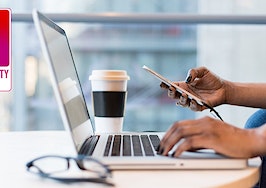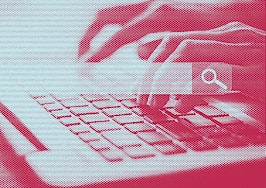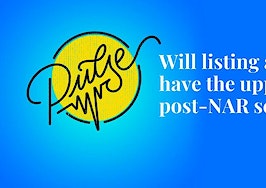Here we are at the one-year mark of the global pandemic, and what once felt distant and “thankfully not happening to me” is now touching approximately 1 in every 5 Americans.
If you’re like me, and have been affected by the virus personally (you can follow my COVID-19 journey here), you know firsthand how the workflow struggles can vary greatly day to day during your recovery.
This uncertainty and stress can generate a ton of anxiety for any real estate professional, especially if you’re typically the driven, go-to person everyone counts on for answers and results. According to the Centers for Disease Control and Prevention (CDC), some of the of the most commonly reported long-term effects of COVID-19 are unrelenting brain fog, fatigue, muscle soreness, headaches, anxiety and depression.
Now, you may be reading this article thinking, “Wait, brain fog and fatigue? Isn’t that something all of us deal with late afternoon or after a virtual meeting or Zoom training?” Although that’s certainly true to a certain degree, for those of us recovering from the novel coronavirus, this type of late-day sluggishness can actually persist all day long.
Medical professionals are still discovering the ins and outs of the virus, new findings tend to pop up daily. However, one of the biggest questions presented by those affected by the virus is: Why does COVID-19 cause neurological symptoms?
According to the preliminary data shared by the Henry Ford Health System, we’ve learned that:
“COVID-19 is neuro-invasive, meaning the virus itself can invade the brain and nearby nerves. Something as simple as loss of smell, which is a symptom of COVID-19, indicates a neuro invasion because the nerves that are responsible for smell are in direct connection with brain. The virus can induce a large-scale immune response and that immune response can cause a cytokine storm, which is an excessive mobilization of the immune system.”
As a busy real estate professional, this type of workflow disruption can clearly cause underlying professional anxiety, especially considering that our daily roles require us to be master multitaskers and solvers of seemingly all problems. But don’t worry, we’ve got you covered. Below are our 10 tips for returning to work post-COVID-19.
1. Up your communication game
Internally: Brokerage, support staff and teammates
This may seem like a no-brainer (no pun intended), but take a few moments at the beginning of each week to check in with your broker, support staff and team. Let them know where you’re at in your recovery, and share with them some of the hurdles you’re currently facing.
Even if you’re typically super private, giving those who support you the opportunity to better understand where you’re at in the healing process will give them the information they need to prioritize their asks of you.
Externally: Clients and social media
First and foremost, make sure you’re following your state-mandated guidelines regarding quarantine timeframes, and certainly don’t go out into the field to meet with clients until you meet the requirements for both your state and brokerage. (Those terms vary state to state and brokerage to brokerage.)
Some of you may choose to keep your struggle with COVID-19 private, while others may be more public about their journey. Whichever path you choose, even though your No. 1 priority needs to be about health and safety, you also want to make sure you’re sharing a tone of reassurance to your clients.
You’ll want to clearly convey to onlookers that you are now healthy, safe to be around and fully capable of fulfilling their needs. If you plan to conduct in-person meetings, take the time to revisit your COVID-19 safety plan, and regularly share and reinforce your protocols on social media to reassure everyone that you’re taking the necessary precautions to keep everyone safe.
If you’re working exclusively in virtual world, be sure to regularly share what no-contact services you currently have available, and give specific examples about how this mode of online service has been successful for your clients over the past year.
2. Adopt coworking and delegation strategies
Now that you’ve got your communication dialed in, you’ll want to consider what areas of your business do you tend to get overwhelmed by easily. Is it posting on social media? Entering data into the MLS? Setting up direct mailers? Reviewing contracts? Scheduling inspections?
Take inventory of the things that require the most time, and look to see who in your office you can partner with to ensure your clients’ needs are always met in a timely manner. If you don’t have access to teammates, consider utilizing a platform, such as BrokerAssist, to gig out some of the parts of your business that tie you down.
Another option is to delegate out non-real-estate-related tasks to a virtual assistant. Popular platforms used by many agents are Fiverr or Upwork. Services such as these are typically very affordable. Even when you’re 100 percent back in the game, you may continue this practice of delegation once you realize how incredibly helpful hiring a virtual assistant can be.
3. Practice time-blocking
Getting back into the flow of things post-COVID can be really overwhelming, especially if you spent a lot of time on bed rest and had experienced an interrupted sleep schedule.
Ease some of your own anxiety about feeling nonproductive or forgetting something by using your calendar app to book appointments for yourself throughout the day. For instance, you might schedule coffee and emails (8 a.m. to 9 a.m.), clients calls (10 a.m. to 11 a.m.), contract review (1 p.m. to 2 p.m.), social media (3 p.m. to 4 p.m.), etc.
Also, try to challenge yourself to accomplish at least one difficult task each day. By setting this healthy boundary with yourself, you’ll be less likely to wrestle with relapse exhaustion. Moreover, you’ll be productive enough that you’ll find yourself caught up in no time flat.
4. Move around, and change your scenery
One of the biggest challenges of jumping back into work mode is the strain that staring at a computer screen can place on your eyes. One of the easiest hacks to avoid eye fatigue (which, by the way, often leads to headaches) is to set an alert on your phone that reminds you to take a break every hour.
Whether it’s walking to the other side of the house and looking out the window for a few minutes, or physically taking your laptop with you and working from a different part of the house for a bit, these small scenery changes not only give your eyes a temporary break, they also trick your brain into thinking you’re doing something new and exciting.
Also, consider adding some plants to your workspace. Even the simple act of rearranging plants on your desk can work in a pinch as well. (Personally, I love to mix in some colorful flowers in mini vases all over the place to create a happy and fragrant perspective-changer!)
5. Integrate daily stretching
Don’t worry; I’m not suggesting that you should shirk your career responsibilities and suddenly turn into a hardcore workout Barbie or Ken. However, since the brain fog element is typically partnered with headaches and neck stiffness, during one of your hourly mini breaks, roll out your yoga mat, and stretch your limbs for a few minutes.
Simple stretches can not only aid in your recovery process, but they may also help you fight off future sickness as well as generate an immediate improvement in your overall feeling of wellness. (That said, always make sure to consult your physician through your recovery process).
One of the most user-friendly resources I’ve found during my own recovery process was provided by UT Southwestern Medical Center. Dr. Kim Barker, M.D., associate professor in the department of Physical Medicine and Rehabilitation, shared some really great tips and short videos on simple stretches anyone can do from home that will aid in your post-COVID recovery process.
If you’re not a big fan of traditional stretches, head over to your doorway, extend your arms to the top of the door frame, and bend into a stretch. Or maybe just alternate hanging your heels off a bottom stair while holding onto the sidewall or rail. Even little stretches like these will help boost your productivity while increasing your overall mobility as you continue the healing process.
6. Snack on healthy foods
Another challenge for busy and healthy real estate professionals on the go (or just consistently buried by workload), no less those recovering from COVID-19, is finding the time to eat.
As rudimentary as it may seem, according to Eatingwell.com, with a little bit of preparation, we can continue our healing process while working, gain mental clarity and prevent relapses by equipping ourselves with healthy snacking options that can assist in the anti-inflammatory process.
Instead of grabbing popular go-to snacks — think: granola bars, buttery or cheddar-like crackers, popcorn and coffee drinks — consider stocking your kitchen with hard-boiled eggs, avocados, toasted chickpeas, black bean soups, hummus, nut butters, almonds and even dark chocolate squares.
7. Don’t forget your vitamins
This is the part of the article where I realize I probably sound like a total mom — “Don’t forget to take your vitamins, kids!” But seriously, consider consulting with your physician about adding vitamins (as well as the recommended dietary dose) to your recovery plan.
There’s some evidence to support the practice of adding a variety of immunity boosting supplements (like vitamin D, B, C, elderberry, melatonin and zinc) into your daily routine. In fact, if you were using any of these during your treatment phase, don’t forget to continue the process during recovery phase as well, if your doctor recommends it.
Just because you’re starting to feel better doesn’t mean your body still doesn’t need those extra nutrients to keep on fighting. Pro tip: Consider talking to your physician about shifting your melatonin intake back to before bedtime so you don’t make yourself drowsy during the workday.
8. Try mini meditations
During one of your daily breaks, consider a quick meditation. This doesn’t have to be anything complicated. It can be as simple as closing your eyes and focusing on something that brings you joy. You could also tune into a meditation playlist on your music streaming service. (However, I’d recommend focus or energizing music versus relaxing. You don’t want to fall asleep!)
There’s also an iPhone app called “Smiling Mind” that you may find useful. It’s a free meditation app developed by psychologists and educators that offers a wide variety of simple meditation programs for all ages. It’s particularly useful if your anxiety is virus-related.
9. Get some fresh air
This is probably one of the easiest solutions to ward off fatigue, brain fog and anxiety, but for some reason, this easy practice is the one we, as real estate professionals, tend to forget to do most often.
According to The Joint Chiropractic, simply stepping outside to breathe in some fresh air (or somewhat fresh, as I live just outside Los Angeles, and my air is likely less awesome than most of yours), quickly energizes, boosts our mood, increases oxygen flow to our brain and instantly brings clarity to even the foggiest of minds.
Oh, and guess what? Even a little bit of movement outside can help build up our immune systems. Even if it’s raining or cold outside, grab your galoshes, your umbrella or your winter coat, and reap the benefits of good ole Mother Nature for a few minutes here and there throughout your workday.
10. Be kind to yourself
Last but not least, give yourself the room to be less than perfect. You might find that tasks that used to take you an hour to complete now take you three. Or maybe your creativity or problem-solving skillsets feel sporadic or completely nonexistent.
Instead of getting super flustered and beating yourself up, consider tracking every little thing you accomplish during the day. From the moment you wake up, until the moment you go to sleep, make a note of every time you complete something new (you brushed your teeth, made the kids breakfast, responded to 10 emails, completed a contract, scheduled social posts, did digital door-knocking, returned phone calls, ate lunch, checked the mail, did a load of laundry, took out the trash, loaded the dishwasher, texted clients, sent out thank-you cards).
Whatever it is you did, use your talk-to-text feature on your cell phone, and record your mini wins into the notes app on your phone. This simple practice of noticing everything you accomplish — big and small — will help you shift your mindset and recognize just how much you actually do in a day. You’ll be surprised.
Over time, it will help you shift and adjust your daily habits when you’re trying to figure out where your time is best spent and where your time has gone. I use this trick often, and I promise you — it really works!
In conclusion, whether you choose to adopt one or two of these strategies, or you decide to make a total overhaul and adopt them all, don’t forget to regularly pat yourself on the back for your courage and strength in fighting off this virus.
Take the time to thank your body daily for working hard to fight off COVID-19, and for keeping you strong and healthy. For most of us, no matter how difficult some of our post-COVID workdays have been or will be, it’s helpful to keep in mind that this is just a temporary side effect that will eventually fade in time.
Stacey Soleil is a marketing and technology director with WEST, a Williston Financial Group Company, in California. Connect with her on Instagram and LinkedIn.













